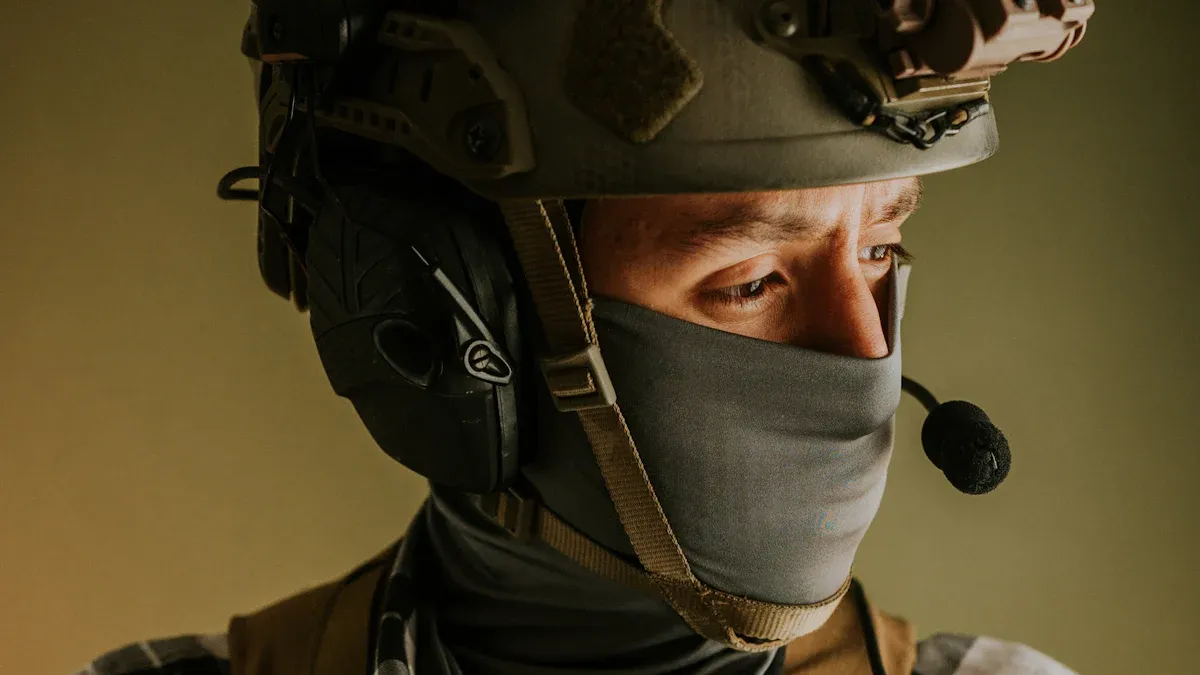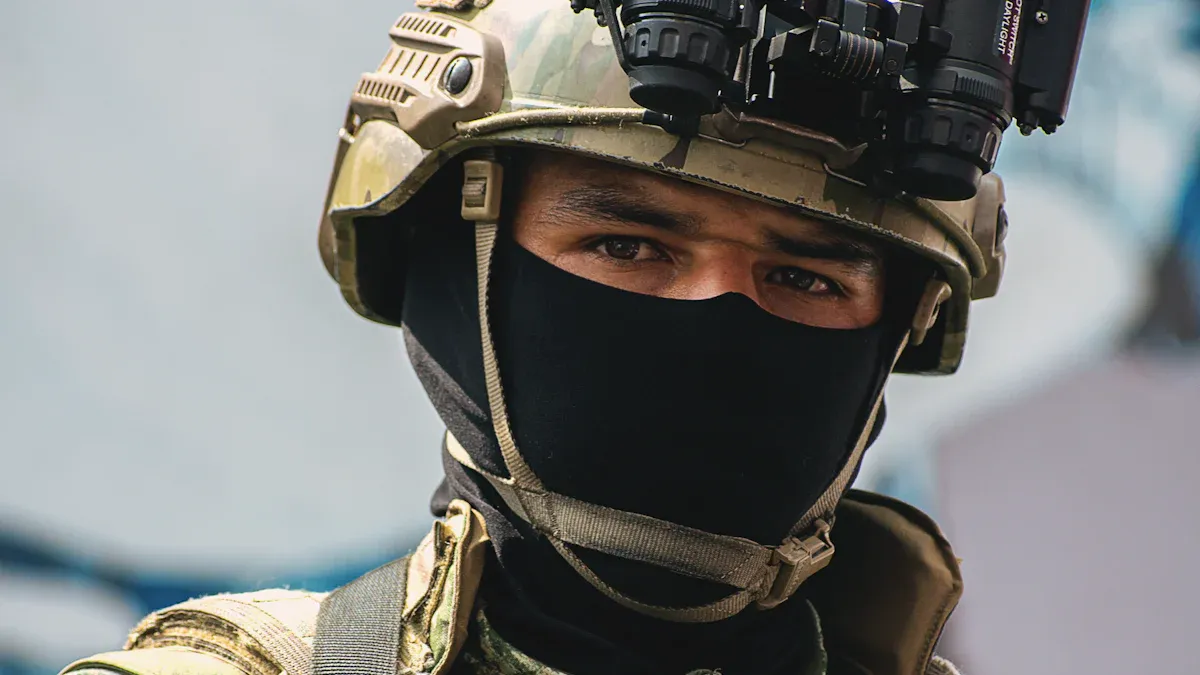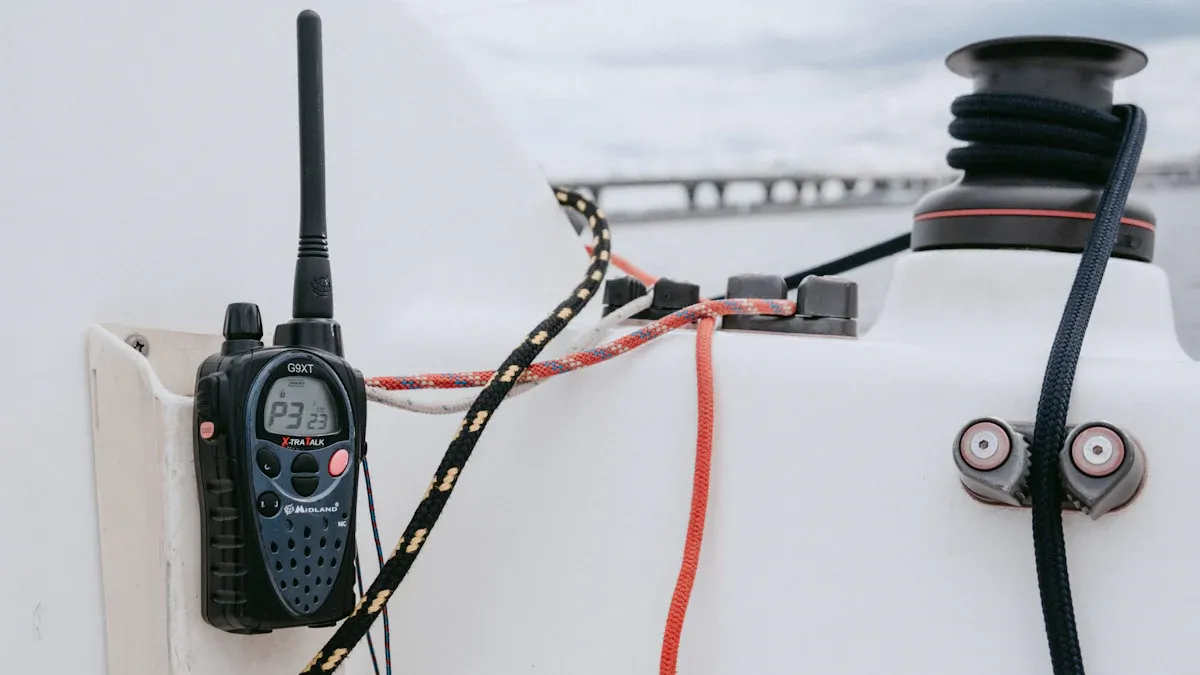Overcoming Challenges in Military Wireless Communication

Military wireless communications are crucial for today’s missions. These systems enable teams to collaborate effectively and remain updated in real time. By 2025, military teams are expected to manage over 100,000 devices, marking a significant 500% increase from 2015. Enhanced communication tools have made identifying threats 40% easier during NATO drills. Military aircraft generate 844 terabytes of data every hour, highlighting the necessity for secure and rapid systems. Clearly, military wireless communications play a vital role in mission success and the efficiency of operations.
Key Takeaways
Military wireless communication helps teams work together and share data fast.
Tough conditions and online threats make systems need to be safe and strong.
New tech like 5G, AI, and quantum encryption makes communication faster and safer.
Different military systems must work well together to stop delays and confusion.
Using better tools and methods helps teams stay ready and handle problems well.
Challenges in Military Wireless Communications

Environmental and Operational Factors
Military wireless systems face big problems in tough places. These include jungles, deserts, and mountains. Harsh weather can break communication tools. Heat, shocks, and vibrations make equipment wear out fast. Unlike regular devices, military tools must work in hard battlefield conditions. For instance, desert systems must handle sandstorms. Arctic systems need to work in freezing cold.
Operations make things harder too. In wars, enemies may jam signals or steal data. Cyberattacks can target networks. This means systems must be secure and flexible. Soldiers also need mobile tools that work without fixed setups. This ensures smooth communication during missions.
Note: Military tools need top security and reliability. They must pass strict tests to work well in missions.
Challenge Type | Description |
|---|---|
Complexity of Military Systems | Military tools are very advanced. They need careful testing to ensure they work well, especially for important tasks. |
Tolerance for Extreme Conditions | Military devices must survive tough places like jungles and deserts. They need to handle heat, shocks, and vibrations, unlike regular gadgets. |
Risks of Using Commercial Technologies | Using regular tech in military systems can be risky. Enemies might find weaknesses in common parts. This means military networks need to be stronger. |
Bandwidth and Spectrum Limitations
Bandwidth and spectrum issues are big problems too. More devices in missions mean higher bandwidth needs. For example, drones, wearable tech, and wireless tools need strong connections. But there isn’t always enough spectrum, causing signal problems.
Spectrum crowding makes global missions harder. Teams must share spectrum across countries, especially with allies. New tech like 5G and 6G adds more pressure on bandwidth. Without good spectrum planning, systems may fail to send real-time data.
Key Insights on Bandwidth Challenges:
Spectrum crowding is a major issue.
Limited military spectrum causes signal problems.
Sharing spectrum across countries is tricky.
New tech needs more bandwidth.
Programs like SMART aim to fix these problems. They focus on real-time spectrum tools to improve communication and efficiency.
Security Threats in Military Communications
Security is one of the hardest challenges. Cyberattacks and electronic warfare keep changing. Enemies may find weak spots in regular tech used in military systems. These attacks can steal data or stop communication.
To fight this, strong cybersecurity is needed. AI tools can find and stop cyber threats quickly. Encryption helps keep messages safe. But staying secure means always improving. Military teams must use new tech and test systems often.
Tip: Always choose secure systems that can handle cyber and electronic attacks. This keeps military communication reliable during missions.
Interoperability in Military Communication Systems
Interoperability means different military systems can work well together. Without it, missions may face delays or miscommunication. This can even lead to mission failure. But why is this so hard? Military forces use many technologies with different rules and setups. If these systems don’t connect, communication breaks down.
One way to fix this is using advanced tools like Mockets. Mockets work better than older systems like TCP. Here’s how Mockets perform in tough conditions:
Aspect | Findings |
|---|---|
Communication Protocol | Mockets sent data better than TCP in tough situations. |
Latency Reduction | Mockets cut delays by over one third compared to TCP. |
Throughput Improvement | Mockets doubled data speed compared to TCP in wireless areas. |
Tactical Networking Issues | Systems struggle with limited and unstable bandwidth. |
Importance of Research | Helps soldiers communicate in remote and dangerous places. |
To check interoperability, tools like the Army Interoperability Measurement System (AIMS) are used. AIMS tests systems during drills and asks key questions:
Can your system connect with others?
Have you tested how well it connects?
Why isn’t it connecting properly?
By asking these questions, gaps can be found and fixed. This ensures soldiers have dependable tools, even in tough environments.
Tip: Always focus on interoperability when building or improving systems. It lowers risks and boosts mission success.
Latency and Real-Time Communication Demands
Latency is the delay in sending data. It can hurt military missions. In critical moments, even a small delay can cause failure. Systems must send data instantly for quick decisions and smooth operations.
Time-Sensitive Networking (TSN) helps solve this problem. It sends important data first, like urgent commands or updates. This ensures soldiers get vital information quickly. TSN also has backup features to keep networks running in tough places, like cities or remote areas.
Here’s why TSN is helpful:
Prioritization of critical data: Important updates are sent first for faster responses.
Enhanced reliability in challenging environments: Backup systems keep networks working in tough spots.
Reduced latency for real-time decision-making: Faster data helps leaders make quick, smart choices.
Using TSN can solve latency problems and meet modern military needs. This is crucial in areas with cyber threats or electronic attacks. Reliable communication helps respond to dangers effectively.
Note: Reducing latency isn’t just about speed. It’s about getting the right info to the right people on time.
Solutions to Overcome Challenges in Military Communications
Advanced Antenna and Signal Processing Technologies
New antenna and signal tools are improving military communication. These tools help send and receive signals better in tough places. Old systems had slow responses and limited bandwidth. Modern systems are faster, cover more areas, and handle threats well.
Adaptive antennas aim signals at targets to avoid interference. Signal tools clean and check data quickly for safe communication. These upgrades make missions more successful and give soldiers an edge in tough situations.
Metric | Old Systems | New Systems | Improvement |
|---|---|---|---|
Reaction Time | 30-60 seconds | Less than 1 second | |
Bandwidth Coverage | Few bands | Full spectrum | About 400% |
Handling Unknown Threats | Weak | Strong | Big leap |
Mission Success Rate | 60-70% | 85-95% | Around 35% |
Using these tools ensures reliable communication. This is key for safe missions and staying ahead in the field.
AI-Driven Cybersecurity for Military Communication Systems
Cyber threats keep changing, so strong protection is needed. AI tools are helping defend military networks from attacks. These tools find patterns in cyber threats and react quickly.
AI predicts weak spots in networks before they become problems. For example:
AI blocks hackers from entering military networks.
It spots attack patterns to stop threats fast.
Research on AI tools keeps networks and soldiers safe.
Adding AI to military systems makes communication secure. It also protects data during missions, helping teams succeed.
Integrated Systems for Interoperability in Military Communications
Interoperability means different systems work well together. Without it, delays and confusion can happen. This may hurt missions.
Modern systems connect devices and networks easily. For example, secure radios link with other tools for smooth teamwork. These systems also share data quickly, helping leaders make smart choices.
To improve interoperability, focus on systems that adapt and connect well. This makes communication better and keeps operations safe. Investing in these systems solves tech problems and helps soldiers stay ahead.
Adoption of 5G and 6G in Military Communication Systems
5G and 6G are changing military communication. These new technologies make communication faster and safer. With 5G, data can move at 10 gigabits per second. This speed helps share information instantly during missions. Latency, or delay, is as low as 1 millisecond. This quick response is important for drones, teamwork, and robots.
5G connects many devices at once. This is useful for tools like sensors and wearable tech. It ensures all devices work well together, even in busy areas. Network slicing is another feature. It lets you set up special services for different tasks, saving resources.
Dr. Thomas Rondeau says 5G’s higher frequency makes communication safer. This is important for secure and flexible military operations. As 6G develops, it will bring even better features. It will cover all areas, work faster, and handle tough conditions. These upgrades will help in hard missions.
5G also uses less energy. This makes it great for portable devices and long missions. By using 5G now and preparing for 6G, military teams stay ahead with the best tools.
Software-Defined Radios for Enhanced Flexibility
Software-defined radios (SDRs) are improving military communication. Unlike old radios, SDRs use software to work. This makes them easy to update and change. They can connect with many devices and work on different frequencies.
One big benefit of SDRs is their small size. They add more features without being heavy or bulky. This is helpful for soldiers and vehicles where space matters.
SDRs like FlexLink are very flexible. They switch between communication types easily. This keeps connections strong in cities or remote places. SDRs adjust to the environment, helping teams stay connected.
Another great feature is handling many tasks. SDRs can send voice, data, and video. This means fewer devices are needed, making things simpler. Adding SDRs to military systems improves communication and makes missions more efficient.
The Future of Military Wireless Communications

Quantum Encryption for Military Communication Systems
Quantum encryption is changing military communication by offering strong security. It uses quantum mechanics to protect data, unlike older methods. This makes it very hard for enemies to steal or decode secret information. Countries are spending a lot on quantum technologies to stay ahead. NATO allies are using shared encryption tools for smooth teamwork. Middle Eastern nations use satellites with quantum keys to secure networks. African countries use portable quantum devices to protect borders.
The military is quickly adopting quantum advancements. These tools improve encryption and help with awareness using quantum sensors. By 2025, awareness tools will make up 42% of the market. This growth comes from quantum-proof encryption and AI. As quantum computing improves, it will change logistics, cryptography, and simulations. This ensures safe and smart operations.
Tip: Start using quantum encryption now to prepare for future security needs.
Autonomous and Self-Healing Networks
Self-healing and autonomous networks solve many military communication problems. These networks fix themselves and adapt without human help. Phantom Networks adjust setups and mix protocols for better communication. Self-healing networks keep working in tough conditions using strong RF paths. Heterogeneous networks combine different technologies for smooth operation.
Technology | Features | Benefits for Military Communication |
|---|---|---|
Phantom Networks | Adjusts setups, mixes protocols | Improves communication in changing environments |
Self-Healing Networks | Strong RF paths, works in tough places | Keeps communication going even in bad conditions |
Heterogeneous Networks | Combines different technologies | Adapts to changing needs in military missions |
These networks keep communication running, even in hard situations. PhantomBlu’s mesh networking and fast data speeds help process information secretly and quickly. Using these tools ensures missions stay flexible and connected.
Edge Computing for Real-Time Military Communications
Edge computing is improving how data is handled in military missions. It processes data where it is collected, not in faraway clouds. This cuts response times to milliseconds, helping teams act fast. For example, the U.S. Air Force uses edge computing to spot threats and respond instantly.
This tech supports independent decision-making in tough situations. It also improves battlefield views by handling data locally. Tactical edge computing helps drones move and react faster, keeping soldiers connected in hard areas.
Note: Edge computing keeps operations running even if main command links fail. It’s vital for modern military communication systems.
Satellite Communication for Global Military Operations
Satellites are key for modern military missions. They provide worldwide connections, even in hard-to-reach or dangerous places. These systems help send secure data, give real-time commands, and improve awareness during missions.
Low Earth Orbit (LEO) satellites are very popular. They send data faster and with less delay. This is important for military tasks needing quick and steady communication. Many governments are spending a lot on satellite systems. This ensures smooth communication for troops, even in tough situations.
The value of military satellites is growing fast. In 2023, it was worth $16.4 billion. By 2033, it may grow to $33.2 billion, with a yearly growth of 7.3%. Satellites are used for spying, tracking, guiding, and warning about missiles. Small satellites are also useful because they resist attacks better.
Tip: Using satellites keeps your team connected and informed anywhere.
Main benefits of satellite communication:
Global coverage: Works in remote and hard-to-reach areas.
Secure communication: Keeps military data safe from hackers.
Real-time data transfer: Helps make quick decisions during missions.
Adding satellite tech to missions gives you an advantage. It helps you act fast and stay in control in changing situations.
AI and Machine Learning in Military Communication Optimization
AI and machine learning (ML) are changing how military communication works. These tools study large amounts of data to find patterns. AI can predict problems and manage resources better. This keeps communication running smoothly during important missions.
AI tools also make networks safer by stopping threats quickly. For example, ML can spot strange activity and block cyberattacks before they happen. This keeps systems safe and working well.
ML also helps leaders make better choices. It processes data faster than older methods. AI can study battlefield conditions and adjust communication plans. It also sends the most important updates first.
Note: Adding AI and ML improves efficiency and protects against new dangers.
How AI and ML help military communication:
Better network performance: AI uses bandwidth wisely and cuts delays.
Stronger security: ML finds and stops cyber threats.
Faster decisions: AI handles data quickly for instant actions.
Using AI and ML makes communication systems strong and flexible. These tools help you stay ready in a constantly changing battlefield.
Military wireless communication has many problems, like system mismatches and language issues. Misunderstandings, such as the accidental bombing of Canadian troops, show why secure systems are crucial. New tools, like AI and smart drones, are improving communication. For instance, using AI in Small Unit Maneuver (AISUM) boosted awareness and earned a $60 million deal. Ongoing improvements help teams adapt to tough situations, stay ahead, and handle new dangers well.
FAQ
How is military communication different from civilian systems?
Military systems focus on safety, strength, and flexibility. They work in tough places and survive bad conditions. Unlike civilian tools, they use strong encryption, special signals, and durable equipment to keep communication steady during important missions.
Why is latency a big problem in military communication?
Latency is the time it takes for data to travel. In military missions, even a small delay can cause problems. Fast communication helps teams act quickly, work together better, and succeed in critical situations.
How does 5G help military communication?
5G makes data move faster, lowers delays, and connects more devices. It gives real-time updates, improves drones, and boosts wearable tech. These features make 5G perfect for missions needing speed and accuracy.
What do satellites do for military communication?
Satellites give worldwide coverage, safe data sharing, and instant communication. They link soldiers in faraway places, help with spying, and track missiles. Low Earth Orbit (LEO) satellites send data faster, making communication more reliable.
How does AI improve military communication?
AI makes communication stronger by spotting problems early, saving bandwidth, and stopping cyberattacks. It works fast, sends important updates first, and keeps systems safe. These tools help teams stay ready in changing battlefields.
See Also
A Comprehensive Guide To Understanding Communication Chips
